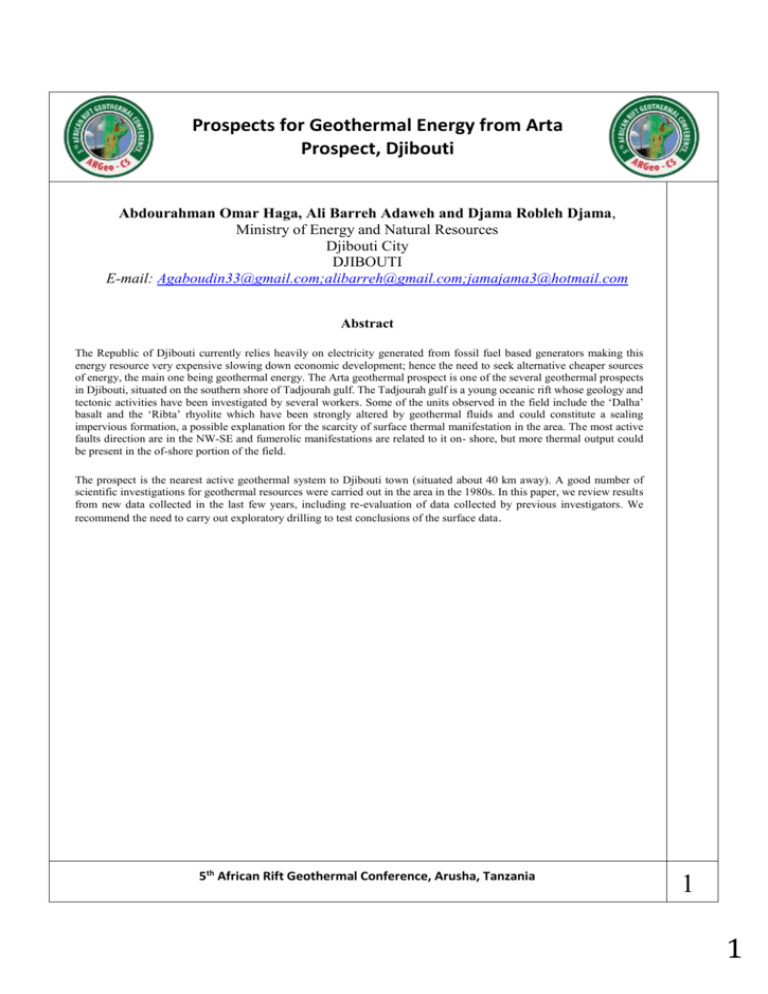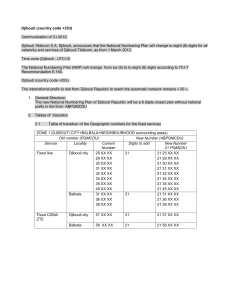Prospects for Geothermal Energy from Arta Prospect
advertisement

Prospects for Geothermal Energy from Arta Prospect, Djibouti Abdourahman Omar Haga, Ali Barreh Adaweh and Djama Robleh Djama, Ministry of Energy and Natural Resources Djibouti City DJIBOUTI E-mail: Agaboudin33@gmail.com;alibarreh@gmail.com;jamajama3@hotmail.com Abstract The Republic of Djibouti currently relies heavily on electricity generated from fossil fuel based generators making this energy resource very expensive slowing down economic development; hence the need to seek alternative cheaper sources of energy, the main one being geothermal energy. The Arta geothermal prospect is one of the several geothermal prospects in Djibouti, situated on the southern shore of Tadjourah gulf. The Tadjourah gulf is a young oceanic rift whose geology and tectonic activities have been investigated by several workers. Some of the units observed in the field include the ‘Dalha’ basalt and the ‘Ribta’ rhyolite which have been strongly altered by geothermal fluids and could constitute a sealing impervious formation, a possible explanation for the scarcity of surface thermal manifestation in the area. The most active faults direction are in the NW-SE and fumerolic manifestations are related to it on- shore, but more thermal output could be present in the of-shore portion of the field. The prospect is the nearest active geothermal system to Djibouti town (situated about 40 km away). A good number of scientific investigations for geothermal resources were carried out in the area in the 1980s. In this paper, we review results from new data collected in the last few years, including re-evaluation of data collected by previous investigators. We recommend the need to carry out exploratory drilling to test conclusions of the surface data . 5th African Rift Geothermal Conference, Arusha, Tanzania 1 1 1. INTRODUCTION The Republic of Djibouti is not energy independent (80 percent of the energy consumed is purchased from Ethiopia while 20 percent comes from oil-fired power plant (currently very expensive commodity.) To overcome this dependence in energy, the Government of Djibouti is currently considering geothermal energy development as first priority. Considering the great increase of energy demand in the country (87MW in 2014 to around 314MW at 2027), it seems urgent to reassess the earlier studies carried out on the nearest geothermal system to the capital of the country namely geothermal field of Arta and propose (taking into account the new data acquired in 2011 and 2014 by the Ministry of Energy and Natural Resources (MENR)) additional new studies needed to rapidly develop this resource lying at the door of Djibouti city. Fig.1: Djibouti location 2. ENERGY DEMAND Located on the southern edge of the medio-oceanic rift Gulf Tadjoura the Arta geothermal site is located approximately 40 km from the city of Djibouti(fig.2). The town of Arta has a mild climate because 750 above sea level located a dozen miles. With a few thousand villas and senior executives Djibouti, it is just a few kilometers from the highway corridor (Djibouti-Addis) and power grid interconnection (Djibouti-Dire Dawa). The two villages of Arta and Wea are supplied with electricity from Djibouti city. The energy consumed in these villages is not very high> 2MW. But the expansion of these villages and the development of tourism around the beaches of Arta certainly will lead a higher energy requirement. 2 Fig.2: Arta geothermal prospect (black rectangle at the southern edge of Tadjoura gulf) Because of the proximity of the capital of the country, most especially our concern about the energy demand of the city of Djibouti. According to forecasts of EdD (Government agency responsible for the production and distribution of energy power in the Republic of Djibouti), there is a strong growth in demand since 2000(fig3). Fig.3: Energy demand grow from 1972 to 2012 ( source EDD) With future large projects (big energy consumers), it is to predict a growth in demand of about 4.5% per year. These projects are: 1. Desalination plant 2. Extension of the container terminal of Dorale 3 Free Zone of ‘’Japaan As ‘’ 4 New polyvalent Doralé port 5. Cement PK12 and Ali Sabieh 6. Goubet Port 7. Port Tadjoura 8. Repair boats Site 9. CHebelleh Airport 10. Railway Djibouti-Galilee 11. Railway Tadjoura Galafi 3 3. PREVIOUS STUDIES 3.1) General Geology Several European researchers have conducted studies on the region since the 70s. To cite only a few: nsforming region of Arta. Republic of Djibouti. -seismicity of the Gulf of Tadjoura, tectonic and plate boundary. Studies in the 70s by the French CNRS and the Italian CNR have identified the main geological formations and define the geodynamic evolution of AFAR. Arthaud et al described the chronology of tectonic phases of the Arta transverse area. 3.2) Geothermal Exploration surface in the Arta region in 1982 Geological, geophysical and geochemical study was undertaken in 80 years for a private Italian company (Geothermica Italiana). These geological studies have allowed defining the sequence of geological formations of the region and the main tectonic directions affecting the rocks. The rocks exposed in this area are from the oldest to the most recent: - The basaltic Dalha serie (5.9-3.6 my). - The rhyolitic Ribta serie (3.6 my). - stratoid basaltic serie (3.3-2 My). -Tadjoura Gulf basaltic serie (2.8-1 my). - The recent sedimentary series. A main tectonic NE-SW direction was determined on the area. In geochemistry, 16 samples were collected during this exploration. Two types of water were determined from the analysis of surface water: alkaline-bicarbonate type characterizing the superficial ground water and an alkali-chloride-type that can have a relationship with the sea water. Geochemical temperature determinations of the two types of water give respectively 75 ° C and 95 ° C. The content of ammonia in fumaroles vapor could come from a shallow boiling reservoir (100 ° C) of alkali-chlorinated water (géothermica italiana 1982). A gravimetric and electrical study was also performed. These geophysical studies confirm the tectonic directions defined by the geological survey and show the existence of a thick layer of highly altered rock that can be a roof insulating a deep geothermal system. 4 STRUCTURE GENERAL PROSPECT OF ARTA The so-called Arta sector is structurally formed by a bulge of N-S direction (Robineau & al1980) which some researcher considers a transform fault tip while others see it as an anticline formed by the magmatic intrusion of the rhyolitic series of Ribta (3.5mA) (Daoud et al 2011). Cut by two main directions of faults (NE-SW and NW-SE), the region is fragmented into several tilted blocks. It is generally accepted that this structure has caused the ‘jump’ of Gulf of Tadjoura rift toward the emerged Goubeth-Assal area. 4 Fig.4: Block diagram of the Arta region showing relationship between structural units and the different volcanic series (after Arthaud). 5. THE NEW DATA 5.1) hydrothermal surface alteration around the’’QUIQLE ‘’ wadi With the collaboration of a mineral exploration junior(Stratex),we have explored in december 2010 , an area around the ‘’Quiqle ‘’ wadi .Alteration description and sampling was made to determine the possible potentiality in epithermal mineralization of the region. Two areas were determined soon (fig5). The northern alteration area The northern alteration area zone is an area of around 600 m by 100-150 m trending roughly NNE. It’s associated with an inferred fault, the visible alteration is obvious to the eye and gypsum veining and float is the most striking fracture. The geology consists mostly of basalt (Dalha basalt) with some altered felsic ignimbrite ( Ribta Rhyolite) visible in the centre of the zone, younger basalts ( gulf basalt) cap the hills surrounding the zone. The felsic rocks are exposed in the lowest ground and are in places intensely clay ( Kaolinite) altered. This alteration could be the result of acidic vapor (Kaolinitic alteration). The more silicified and pyritic rocks also contains gypsum veins and some patches of chalcedonic silica. The southern alteration area The southern alteration zone has a strike extent of 1000 m and is up to 400 m wide at its widest. Two actives fumaroles were also located and localized smectite alteration was noted in basalt proximal to one vent. Calcite veining is plentiful in the basalt surrounding the fumaroles and gypsum veining appears to be localized in the vicinity of the bigger fumarole but is not as abundant as the northern alteration zone. This zone contains a lot more outcropping rhyolytes and ignimbrite ( Ribta Rhyolite) than the northern zone. The unit generally has a grey-blue color and is mostly a fine matrix with vesicles, small rocks fragments and white clay altered feldspar crystal. Some rhyolite contains flow banding and some flow contains coarse phenocryst of clay altered feldspar, strata generally dip gently to the east (because we are in Eastern part of the Arta dome). Vitreous euhedral hydrothermal quartz crystals are also present in vugs and there is also some chalcedony veinlets in the mineralized rock. Some pyrite was also observed in a weakly altered rhyolite where there was a lot of fracturing (N 90 E). Some banded chalcedonic silica veins were trending N40E and strong green smectite alteration was also noted in some rhyolite. Finally to conclude, the two zones appear to be situated in dilatation zone controlled by the intersection of two faults (NW-SE and NE-SW). 5 Fig.5: Geology around quiqle wadi(light green color is main alteration sectors, black line are faults) (After geothermica italiana) 5.2) 2014 JICA data 5.2.1 Comment on processed satellite images Interpretation of satellite images to detect and delineate hydrothermal alteration surface was carried out by a team of JICA on the ARTA region. Sectors of acid to weakly acidic alteration were also determined by a special process of image processing .The existence of acid alteration detected by satellite image confirms our observations during our exploration in December 2010. Fig.6: interpreted satellite image of ARTA geothermal prospect (acidic alterations are delineated by red color and weakly acidic alteration in yellow color). (JICA source) 6 The early observations of this sector are generally limited to a few km2 around the wadi 'Quiqle' where fumaroles exist. The new satellite interpretation of JICA shows a very large surface hydrothermal alteration from western Arta dome to southeast of the Goubeth el Kharab(fig.6 and 7). Fig.7: geological map of Arta region( dark green are Dalha basalt,red color are ribta rhyolite,light green are stratoid basalt and blue color are gulf Tadjoura basalt) Acidic alteration are delineated by red color and weakly acidic alteration by yellow color.(source JICA) The observation in detail of alterations on the geological map at 1/100 000 in the region southwest of the Gulf of Tadjoura (fig.7), reveals that the Ribta rhyolite are most altered by geothermal fluid .We found the more acidic alteration the intersections of tectonic directions. The fault directions taken by leakage of hydrothermal fluids are mostly NE-SW and NS fractures especially on the anticline Arta .The formations of Dalha , Ribta and Stratoid are more prone to alteration while Gulf of Tadjoura basalt seems affected to a lesser degree. 5.2.2 XRD analysis Some samples of altered rocks were collected during a brief exploration field in April 2014 by a team of JICA -MERN. Samples S2, S3, S5 etS6 are from southern zone alteration while sample S8 was taken from northern area(fig.8) .We here represents only two representatives analyzes 7 Fig.8: sampling point around ‘’quiqle’’wadi Fig.9: XRD analysis of sample n° 2 representing the alteration products of the Dalha basalt Alteration products in sample n°2 are: Gypsum Anhydrite Quartz Calcite Chlorite 8 Smectite Sericite/smectite(mixed layered clay mineral) Fig.10: XRD analysis of sample n°6 representing the alterations products from Ribta rhyolite Alteration products in sample n°6 are: Quartz Hematite Nacrite Sericite/smectite (mixed layered clay minerals These changes are typical of argillic alteration by more or less acidic fluid and confirm the interpretation of satellite images of JICA. At this stage of studies of Arta geothermal prospect, the questions to ask are: why the altering fuid are acid, where they come from and where is the heat source? 6. GEOTHERMAL POTENTIAL IN THE SOUTHERN GULF OF TADJOURA The existence of a mid-ocean rift (Rueg & al1980) in the Gulf of Tadjoura, with magma at depth of less than 10km (Hebert, 2008) and ongoing seismicit, leads to the formation of geothermal fields under the floor of the Gulf (Barrat et al 1993) .These geothermal fields can also be linked by fault to the coast (hydrothermal manifestations are always located near the shore). Although the most promising prospect of the coast south of the Gulf of Tadjoura is the Arta region, we must not neglect the area to either side of the Arta area (fig.11). The southern Gulf of Tadjoura are structurally divided into three parts (Daoud et al 2011): The Arta sector in the strict sense, an area west of Arta to southeastern Goubet El Kharab and an area east of Arta .Each of these three sets have its own characteristics. 9 Fig11: geology and structure of the southern coast of Tadjoura Gulf (after Daoud 2011) The Arta region, the most studied (but still very partial in our opinion) has the largest hydrothermal manifestations and could have as heat source a rhyolitic intrusion or a magma under the floor Gulf or both. In the Western Gulf coast Stratoid and Gulf basalt outcrop , both are affected by E-W and NW-SE faults . Some fumaroles are observed near the shore. In the region located east of Arta outcrops mainly Gulf Tadjoura basalt that are affected by faults of E-W direction and to a lesser degree of NW-SE .The volcano 'Hayabley' (aged less 1millions of years ) located west of the city of Djibouti is the most prominent figure. But several clues indicate the existence of geothermal fluid leak in this suburb of Djibouti-city (Houmed Gaba2006). The water wells in the said sector of PK20 have temperatures between 45°C and 65 ° C and thus signals a positive geothermal anomalies(fig12 and 13) . Also the silica content of the water of these wells is high . Fig.12:situation of high temperature well(FU1B,PK20-9 and AWRLOFOUL 3) 10 Fig.13: altitude versus temperature of water wells near Djibouti town( after Houmed Gaba 2006) Evidence of actual geothermal potential therefore exists throughout the southern Gulf of Tadjoura and therefore we need to identify more specifically the heat source, the possible rocks reservoir and the recharge zone. By clearly identifying the three factors mentioned above, it is possible to localise deep drilling before any geothermal development phase . We therefore propose the following for a general operating program covering the entire southern Gulf of Tadjoura. This first phase (or pre-feasibility) could be achieved with the help of friendly countries competent in geothermal energy. 7. PROPOSED EXPLORATION TO ACHIEVE ● Surface: 1) Geology - Geological mapping at 1/50000 - Mapping of hydrothermal alteration (zonation) It is important to map the rhyolites by differentiating the lavas from pyroclastics flows (which has not been made on the existing maps 1/100000). 2) Geochemistry - Sampling of wells, springs and fumaroles - geochemical analysis(majors, minors and traces elements) - Analysis of the isotopes Studies of fluid inclusions (from hydrothermal alterations) 3) Geophysics - Airborne thermometry to inventory accurately all the hydrothermal manifestations - Electrical, magneto telluric and gravimetric studies - Use of natural seismicity 11 ● Sea: - Thermometry (inventory of hydrothermal manifestations underwater) - Acquire all the results of previous studies of the Gulf of Tadjoura (eg SUMEROUAD1977, CYADEN ) and reinterpretation . 8. CONCLUSION Despite the large study undertaken on the Gulf of Tadjoura and its surrounding, our knowledge of the geothermal system in this area is very limited. However, logic would have led us to explore in priority around the city of Djibouti where the energy demands are highest. To fill this void we offer more detailed studies in the southern coast of the Gulf of Tadjoura . With the creation of a new institution dedicated exclusively to the RD of geothermal energy in the Republic of Djibouti, we shall have in the coming years a fruitful collaborations with institutions specialized in geothermal energy around the world . The decrease in electricity prices, the fight against youth unemployment,the creation of a favorable foreign investment climate are nobles objectives which we must achieve in the shortest possible time References Abdourahman Houmed Gaba (2006)Hydrologie des milieu volcaniques sous climat aride,Ph.D.thesis,Univ.Poitiers Arthaud,F.,Choukroune,andRobineau(1980)Evolution structurale de la zone transformante d’Arta(Republique de djibouti),Bull.Soc.Geol.Fr.,22,909-915. Barberi, F., Borsi, S., Ferrara, G., Marinelli, G., Santacroce, R., Tazieff, H., Varet, J. (1972) Evolution of the Danakil depression (Afar, ethiopia) in light of radiometric age determinations. J.Geol. 80, 720-729. Barrat,j.A.,B.M.Jahn,S.Fourcade, and J.L. Joron(1993),Magma genesisin an ongoing rifting zone:The Tadjoura Gulf,Geochim.Cosmochim.Acta,57,2291-2302, Choukroune P. et al. Tectonics of the westernmost: Gulf of Aden and the Gulf of Tadjoura from submersible observations. Nature 319 (1986) 396-399. Daoud & al (2011)Young rift kinematics in the Tadjoura rift, westhern Gulf of Aden,Tectonics,Vol.30, Edd(2013) umpublished report Gasse & al(1986) Carte geologique de la republique de Djibouti à 1:100 000, feuille de Tadjoura Geothermica Italiana(1980) umpublished report Jica(2014) ,XRD analysis Jica(2014),images satellite Richard, O. et Varet, J., (1979) Study of the transition from a deep oceanic to emerged rift zone: Gulf of Tadjoura, Republique de Djibouti. Int. Symp. Geodyn. Evols. Afro-Arabian System, Roma, 1979 Ruegg J.C., Lepine J.C. et Vincent C. : Sismicité et microsismicité de la dorsale de Tadjoura, tectonique et frontière de plaques. Bull. Soc. Géol. Fr. 7. 22, 6 (1980) - 917-923. Stratex International (2010) unpublished report 12







